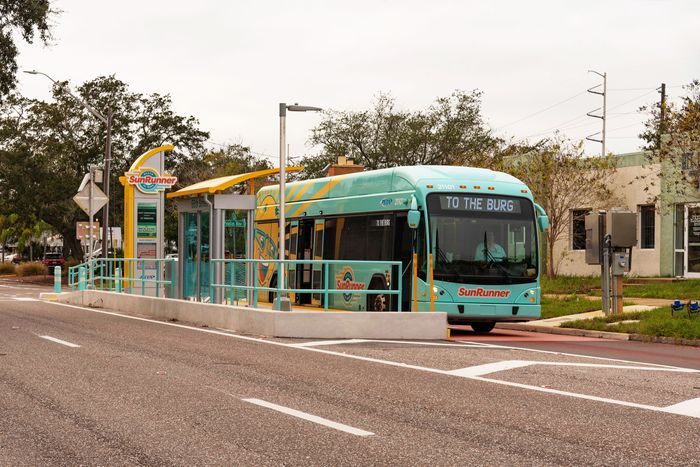
Growing up in St. Louis, Missouri, Cori Bush spent a lot of time waiting for the bus. “It took forever — if it even showed up,” she remembers, but it was the only way to get to and from her grandmother’s home. “It was basically the bus or nothing.” This is part of the reason that Bush made reliable transit a priority when she got to Congress in 2020. Other people were trying to visit their grandmothers, too. But even as more money has been allocated to public transportation under the Biden administration, not enough of it has gone to improving the buses she says her constituents rely on. A bill she’s proposing on Wednesday would make them a priority by specifically funding bus rapid transit — faster, more efficient bus systems using dedicated lanes that can be installed relatively quickly and at a much lower cost compared to other transit improvements. “People depend on the bus in order to operate in their everyday lives,” she says. “They deserve excellent service.”
The Bus Rapid Transit Act would allocate $12 billion per year for five years to BRT projects, funneling dollars directly to transit operations and helping cities invest in the design and construction of new BRT systems, including overhauls of current bus routes. (The funding can also help to fairly compensate overworked bus operators.) An identical bill introduced by Bush for light-rail lines would also allocate $12 billion per year for five years. But the BRT program gives cities more flexibility and more options. The money can also go further. Indianapolis, a city that doesn’t have a rail system, built its wildly popular 13-mile IndyGo BRT line in just a few years and at a fraction of what rail would have cost. The system runs a bus every ten minutes, and the city is now breaking ground on a second 15-mile line. In terms of public-transit interventions, expanding and improving bus systems is tantalizingly low-hanging fruit. But the country doesn’t fund them like the priority they should be. To get the U.S. moving again, 2023 needs to be the year of the bus.
According to a report by Transit Center, which has long argued for federal operations support for transit, only 10 percent of Americans currently live within walking distance of transit that comes every 15 minutes or less. Building high-capacity trains with short headways would fix that, but not all U.S. cities have rail systems. U.S. cities of all sizes have bus systems, and transit access could increase immediately for millions of people by simply increasing how often those buses run, expanding their routes, and updating fleets. Over the last decade, some U.S. cities have tried to speed up their buses with dedicated bus-only lanes, like New York City’s 14th Street Busway, but there are few true BRT systems in the U.S. in terms of features, infrastructure, and frequency — among the most successful are the HealthLine in downtown Cleveland that connects local medical campuses, and L.A. Metro’s Orange line (now the G line), which serves the city’s San Fernando Valley. And capital investment in bus systems generally trails investments in trains. One reason for that is the communities served by buses are often lower income than the communities served by rail, meaning cities don’t prioritize them for improvements. This “spatial mismatch,” as described by a 2020 Urban Institute report looking at transit equity in four U.S. cities, means longer wait times and more expensive commutes that affect Black riders the most: Black workers are four times as likely to rely on transit compared to white workers in the U.S.
The benefits of BRT also go beyond just more on-time commutes. More buses mean cleaner air, fewer emissions, and safer streets because cities with higher rates of transit ridership have lower rates of traffic deaths. “Every day, millions of people take a city bus — the most effective tool we have to stem America’s climate, traffic safety, and equity crises,” says Corinne Kisner, executive director of the National Association of City Transportation Officials. “Elevating, funding, and prioritizing high-quality bus service means more access to jobs, faster trips home to family, less pollution in our cities, and a more vibrant quality of life for everyone.” In 2022, NACTO published the report “Move! That! Bus! Tactics for Transforming Transit in Two Years,” which is filled with case studies where cities from Boston to Seattle experienced immediate benefits by redesigning streets to prioritize buses and offering more frequent, all-day service. But even though BRT is one of the best ways to grow transit ridership and lure people out of their cars, there hasn’t been a dedicated stream of money for BRT until now. Current federal funding mechanisms often include BRT improvements as relatively small capital grants or in concert with multimodal streetscape projects awarded corridor by corridor. Minneapolis, notably, won a recent U.S. Department of Transportation grant to expand its extremely successful BRT system down the city’s Lake Street, but it could tap into the BRT bill to fund the much bigger expansion it’s planning.
For transit systems that truly prioritize buses, the best examples are still found internationally, particularly in South American cities like Curitiba, Brazil, and Bogotá, Colombia, which invented and popularized BRT lines that repurposed highway lanes with iconic station designs for long, colorful buses that come every few minutes. While some BRT-only cities have ridership numbers that rival comparable rail networks, even cities with subways can benefit. In Guangzhou, China, a well-planned BRT system that serves nearly a million passengers per day reduced traffic congestion by 29 percent by simply creating better connections to the existing rail system. Bush’s policy team worked with the Institute for Transportation and Development Policy, which developed global standards for BRT systems, to draft the bill around key elements of these and other successful BRT systems. Elements eligible for funding include features that elevate the bus-riding experience — train-like stations with ample seating and shelter, boarding platforms, ticketing kiosks located outside of the bus — as well as infrastructural improvements, like dedicating separated lanes that allow buses to fly past traffic, keeping them on schedule. New buses purchased will be required to be electric, in the same way federal grants are currently electrifying fleets, zeroing out emissions. Also included are improvements to adjacent pedestrian and bike infrastructure.
A boost for BRT would also help transit agencies struggling to recover from the pandemic. Since plummeting as low as 20 percent in March 2020, transit ridership nationally is now at 67 percent of pre-pandemic numbers, according to American Public Transportation Association data. Many big-city agencies, including the MTA, are struggling to get their numbers back up. But bus ridership rebounded much faster than rail ridership and remains higher to this day, which transit advocates have attributed to the fact that buses serve more people without access to a vehicle who rely on transit to get to work or school. And just because ridership has recovered doesn’t necessarily mean service has been restored. Transit agencies, which do not receive the same federal support as other transportation investments like, say, highways, have struggled with budget shortfalls and labor shortages that have affected frequency. (Lately, the MTA and NYCT Bus Twitter accounts are basically an uninterrupted stream of service-delay announcements.) Buses bear the brunt of any transit-service cuts because, in addition to everything else, if they’re not in dedicated lanes, they also get stuck in traffic, torpedoing their reliability. While rail passengers may not ever return in the same numbers as before, bus riders keep coming back — often because, like Bush’s childhood trips to see her grandmother, they don’t have a choice. They shouldn’t have to keep waiting.




